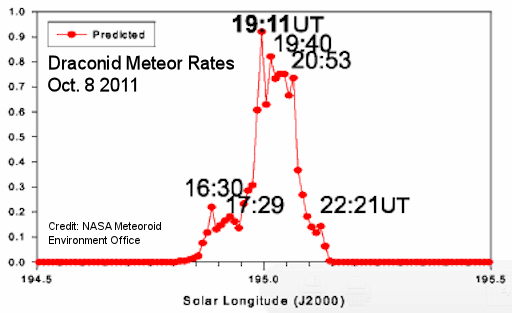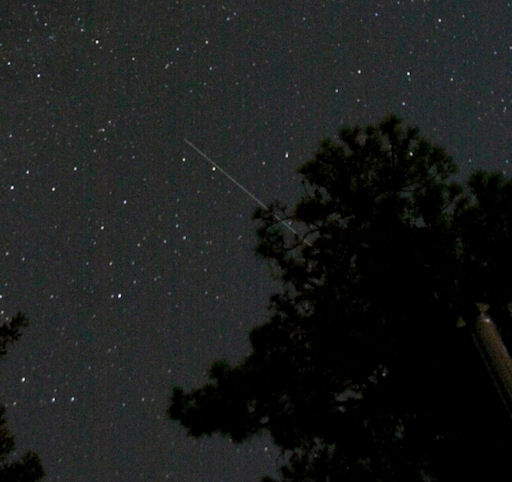 Turn your cell phone into a field-tested satellite tracker. Works for Android and iPhone. |
DRACONID METEOR OUTBURST: On October 8th, Earth will pass through a network of dusty filaments shed by Comet 21P/Giacobini-Zinner. Forecasters expect the encounter to produce anywhere from a few dozen to a thousand meteors per hour visible mainly over Europe, northern Africa and the Middle East. The meteors will stream from the northern constellation Draco--hence their name, the "Draconids."
Peak rates should occur between 1600 UT and 2200 UT (noon - 6 pm EDT) as Earth grazes a series of filaments nearly intersecting our planet's orbit. Analysts at the NASA Meteoroid Environment Office prepared this plot showing how the meteor rate is likely to vary:
If the maximum around 1900 UT reaches 1000 meteors per hour, the 2011 Draconids will be classified as a full-fledged meteor storm. The question is, will anyone see it? Bright moonlight over Europe, Africa and the Middle East will reduce the number of visible meteors 2- to 10-fold. The situation is even worse in North America where the shower occurs in broad daylight.
One way to enjoy the Draconids, no matter where you live, is to listen to them. The Air Force Space Surveillance Radar will be scanning the skies over the USA during the shower. When a Draconid passes through the radar beam--ping!--there will be an echo. Tune in to Space Weather Radio for live audio.
In Europe, an international team of scientists plans to observe the shower from airplanes flying at ~30,000 feet where the thin air reduces the impact of lunar glare. In Bishop, California, a team of high school students will launch an experimental helium balloon to higher altitudes, 100,000 feet or more, where the sky is black even at noon. Cameras in the balloon's payload might catch some Draconid fireballs during the peak hours of the outburst.
Stay tuned for updates as Earth approaches the debris zone.
Draconid resources:
- 2011 Draconid Meteor Shower -- from the International Meteor Organization
- Draconid Risk to Satellites -- from NASA's Meteoroid Environment Office
- Meteor Counter App -- use your iPhone to count meteors and submit the results to NASA
- live meteor radar -- from Spaceweather.com
- Draconid Meteor Outburst -- feature story from Science@NASA
TIANGONG-1 SIGHTINGS: China's first space station, an 8.5-ton experimental module named Tiangong-1 (Heavenly Palace-1), is flying over the United States this week. On Oct. 4th, photographer Tavi Greiner saw it gliding over Shallotte, North Carolina:
"The Tiangong 1 passed between Cygnus and Cassiopeia shortly after sunset," says Greiner. "It was surprisingly bright, easily seen with the unaided eye."
Readers, check Spaceweather's Satellite Tracker for sighting opportunities in your hometown. You can also turn your smartphone into a Tiangong-1 tracker by downloading the Simple Flybys app.
more images: from Jim Saueressig II of Burlington, Kansas; from Justin Cowart of Carbondale, Illinois; from Stuart McDaniel of Lawndale, North Carolina; from Giuseppe of Fisciano, Italy
| Near Earth Asteroids |
On October 7, 2011 there were 1250 potentially hazardous asteroids.
Recent & Upcoming Earth-asteroid encounters:
| Asteroid | Date(UT) | Miss Distance | Mag. | Size |
| 2011 TP | Oct 4 | 7.4 LD | -- | 22 m |
| 2002 AG29 | Oct 9 | 77.1 LD | -- | 1.0 km |
| 2011 TB4 | Oct 10 | 5.2 LD | -- | 35 m |
| 2011 SE97 | Oct 12 | 7.9 LD | -- | 50 m |
| 2011 SS25 | Oct 12 | 69.3 LD | -- | 1.1 km |
| 2000 OJ8 | Oct 13 | 49.8 LD | -- | 2.3 km |
| 2009 TM8 | Oct 17 | 0.9 LD | -- | 8 m |
| 2011 FZ2 | Nov 7 | 75.9 LD | -- | 1.6 km |
| 2005 YU55 | Nov 8 | 0.8 LD | -- | 175 m |
| 1994 CK1 | Nov 16 | 68.8 LD | -- | 1.5 km |
| 1996 FG3 | Nov 23 | 39.5 LD | -- | 1.1 km |
| 2003 WM7 | Dec 9 | 47.6 LD | -- | 1.5 km |
| 1999 XP35 | Dec 20 | 77.5 LD | -- | 1.0 km |
| Essential web links |
| NOAA Space Weather Prediction Center |
| The official U.S. government space weather bureau |
| Atmospheric Optics |
| The first place to look for information about sundogs, pillars, rainbows and related phenomena. |
| Solar Dynamics Observatory |
| Researchers call it a "Hubble for the sun." SDO is the most advanced solar observatory ever. |
| STEREO |
| 3D views of the sun from NASA's Solar and Terrestrial Relations Observatory |
| Solar and Heliospheric Observatory |
| Realtime and archival images of the Sun from SOHO. |
| Daily Sunspot Summaries |
| from the NOAA Space Environment Center |
| Heliophysics |
| the underlying science of space weather |
| Science Central |
| Conquest Graphics |
| for out-of-this-world printing and graphics |
| Trade Show Displays |
| more links... |



No hay comentarios:
Publicar un comentario